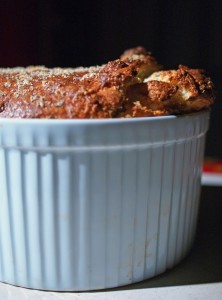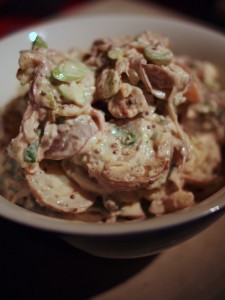
There’s a reason you don’t see souffles on blogs very often. It’s not because they’re particularly difficult or prone to failure (to be honest, I find making a souffle much less of a faff than making a quiche). It’s because unless you’re making a reinforced, twice-cooked, single-portion sort of souffle, centimetres of gorgeous puffiness will subside between your getting the thing out of the oven and focussing the camera on it. Move fast with a souffle, and for maximum impressiveness, make sure everybody in the house is clustered around the oven when you take it out so they can do the “Ooo!” thing in the three seconds before it starts to deflate gently.
It will only lose a few centimetres’ height, but I wish I’d got a picture in a bit earlier. It looked fabulous on exiting the oven, rather than merely very fine indeed, as it does in the photo above. And, of course, it makes for a particularly fine supper, light in texture and dense in flavour all at once. A lovely springtime dish.
To serve 2-3 with a sharp salad and some good bread, you’ll need:
5 eggs
400g smoked haddock
350ml milk
50g butter (plus extra for greasing)
2 heaped tablespoons plain flour
1 heaped tablespoon creme fraiche
50g Parmesan cheese, grated (plus extra for dusting)
15g chives, snipped
1 scant teaspoon chopped tarragon
2 generous tablespoons grainy mustard
Preheat the oven to 190ºC (375ºF). Put the haddock (undyed, if you can find it – I couldn’t) in a small dish, and cover it with the milk. Put the dish, uncovered, in the oven for ten minutes until the fish is cooked lightly. Strain the milk into a jug, remove the skin from the haddock and use your fingers to flake the flesh, removing any bones as you go, and set aside. Grease the inside of a 2l souffle dish very generously, and sprinkle generously inside with grated Parmesan, rolling the bowl around to make sure the cheese sticks all over its inner surface. Separate the eggs, the whites in a large, very clean mixing bowl (any grease on your whisk or in your bowl will affect the lift you can get into your eggs), the yolks in a mug or small bowl.
Combine 50g butter with the flour in a saucepan, and melt them together into a roux. Make a white sauce by beating in the flavoured milk a little at a time over a low flame. Add the creme fraiche, mustard, 50g Parmesan, herbs and flaked haddock to the sauce with the separated yolks. Stir well to combine.
In your large, squeaky-clean bowl, use an electric whisk to beat the whites into glossy peaks. You’ll know when you’re there; tip the bowl. If the eggs are not whisked enough, they will move when the bowl moves.
Use a large metal spoon to add a spoonful of the whisked whites to the haddock mix in the sauce pan to loosen the mixture. Stir well. Now add a spoonful of the loosened sauce to the egg whites, folding it in with the edge of the spoon rather than stirring; you want to end up with as much air still in those whites as possible. Repeat, spoon by spoon, until all the haddock base is folded into the egg whites.
Pour the mixture into the greased and cheese-scattered souffle dish. Sprinkle the top with a little more Parmesan. Slide into the oven and cook for 35 minutes, until puffy, golden on top and a little creamy inside.

